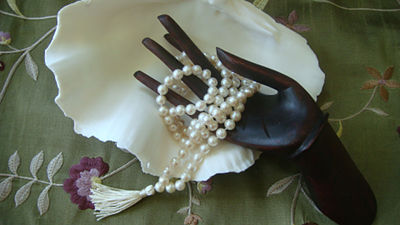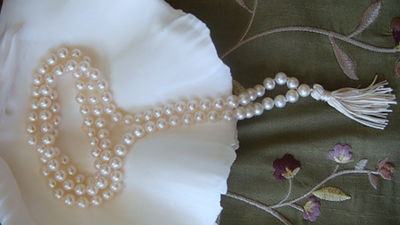 Since the beginning of time, pearls, with their mysterious glow and shimmering iridescence, have been one of the most highly prized gems. Always linked to the Moon, as pearls resemble that celestial body, pearls are symbols of beauty, purity, and love. As the Moon is the deity of the element of water, it rules over the tides of the sea. It represents the mother or female principle, and the energy that creates and preserves. The Moon therefore also rules over growth, fertility, and conception. Pearls are similarly considered to echo the Moon’s energy, and offer the blessings of intuition, imagination, femininity, sensuality, youthfulness, and good fortune.
Since the beginning of time, pearls, with their mysterious glow and shimmering iridescence, have been one of the most highly prized gems. Always linked to the Moon, as pearls resemble that celestial body, pearls are symbols of beauty, purity, and love. As the Moon is the deity of the element of water, it rules over the tides of the sea. It represents the mother or female principle, and the energy that creates and preserves. The Moon therefore also rules over growth, fertility, and conception. Pearls are similarly considered to echo the Moon’s energy, and offer the blessings of intuition, imagination, femininity, sensuality, youthfulness, and good fortune.
A Pearl is born
Far below the surface of the sea, nearly half a world away, a miraculous event takes place – the birth of a natural pearl.
Born from the womb of mother oysters, pearls are truly a gift of nature. Unlike other precious gemstones which are cut and polished to release their inner beauty, pearls come into the world naturally radiant. They emerge miraculously with a shimmering iridescence, and soft luminous glow, which is unlike any other jewel on earth.
A natural pearl occurs when a foreign object, such as a grain of sand, or bit of broken shell, accidentally falls into the soft inner body of the oyster, where it cannot be expelled. The oyster attempts to protect itself from the undesired material by secreting a smooth, hard crystalline substance around the irritant. This substance is often referred to as “nacre.” For as long as the irritant remains, the oyster will continue to secrete layer upon layer of nacre around it. Within a few years of repeating this layering, the result is a lovely and lustrous pearl.
Considerations
 When deciding to purchase a pearl mala, it is important to seek the best quality for your budget. Due to the vast range of colour, size and quality, all pearl malas are custom designed with each individual being consulted regarding their particular needs. Pearls are evaluated on the basis of the following characteristics:
When deciding to purchase a pearl mala, it is important to seek the best quality for your budget. Due to the vast range of colour, size and quality, all pearl malas are custom designed with each individual being consulted regarding their particular needs. Pearls are evaluated on the basis of the following characteristics:
- Lustre – The surface brilliance and capacity to reflex light, just as the Moon reflects the light of the Sun offering a shining, white radiance
- Surface – The absence of organic spots, bumps, or indentations
- Shape – Since pearls are grown by oysters and subject to the whims of Mother Nature, it is rare to find a pearl that is perfectly round. This is one of the primary factors for grading pearls
- Colour – Pearls can vary in colour from white to black, and just about every colour in between. The choice of colour should be determined by the personal preference, with blessing of the Goddess Lakshmi (goddess of prosperity) being offered by pearls that are pure white, or those with just a slight hint of pink or yellow
- Size – Generally the larger the pearl the more valuable it will be. Sizes can range from 1mm to 24mm for a large South Sea pearl. The average pearl sold around the world is 6mm to 7mm
- Natural pearls as compared to cultured pearls. Long ago, before the secret of making pearls was understood, pearls were all produced by nature and were so rare and valuable that they were reserved only for those of royalty or vast wealth. Cultured pearls have been produce for hundreds of years, with the Chinese being the pioneers in this field. More readily available than genuine pearls, cultured pearls are more cost effective, and offer similar effects to the wearer.
